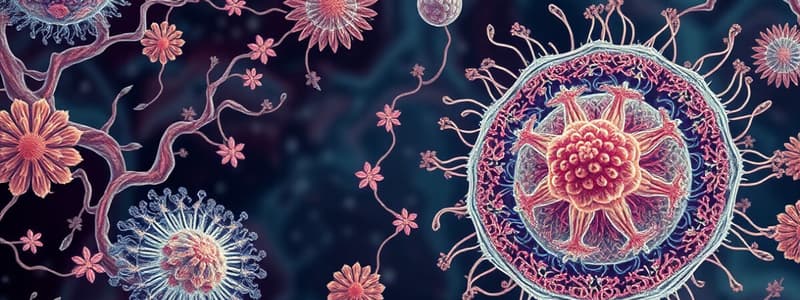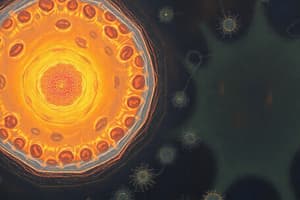Podcast
Questions and Answers
Which of the following is NOT a characteristic of eukaryotic cells?
Which of the following is NOT a characteristic of eukaryotic cells?
- Cytoplasm
- Single circular strand of DNA (correct)
- Cell membrane
- Cell wall
- Nucleus containing DNA
Which of the following is TRUE about prokaryotic cells?
Which of the following is TRUE about prokaryotic cells?
- They are always found in extreme environments.
- They lack membrane-bound organelles. (correct)
- They are larger than eukaryotic cells.
- They have a nucleus containing DNA.
- They do not have a cell membrane.
What is the function of the cell membrane?
What is the function of the cell membrane?
- Provides energy for the cell
- Synthesizes proteins
- Carries out photosynthesis
- Stores genetic information
- Controls what enters and leaves the cell (correct)
Which of the following structures is found ONLY in plant cells?
Which of the following structures is found ONLY in plant cells?
What is the function of the cytoplasm?
What is the function of the cytoplasm?
Which of these structures is NOT found in bacterial cells?
Which of these structures is NOT found in bacterial cells?
The ______ is a liquid substance within a cell where chemical reactions occur.
The ______ is a liquid substance within a cell where chemical reactions occur.
The ______ in plant cells is responsible for photosynthesis.
The ______ in plant cells is responsible for photosynthesis.
What is the purpose of a cell wall in plant cells?
What is the purpose of a cell wall in plant cells?
What are the small rings of DNA found in bacterial cells called?
What are the small rings of DNA found in bacterial cells called?
The prefix 'micro' represents a unit that is 1000 times smaller than the original unit.
The prefix 'micro' represents a unit that is 1000 times smaller than the original unit.
Animal cells have chloroplasts for photosynthesis.
Animal cells have chloroplasts for photosynthesis.
The nucleus of a cell is responsible for protein synthesis.
The nucleus of a cell is responsible for protein synthesis.
Mitochondria are found in both plant and animal cells.
Mitochondria are found in both plant and animal cells.
Flashcards
Prokaryote
Prokaryote
A single-celled organism without a nucleus or other membrane-bound organelles.
Eukaryote
Eukaryote
A cell that has a nucleus and other membrane-bound organelles.
Cell membrane
Cell membrane
The outer boundary of a cell that controls what enters and leaves.
Cytoplasm
Cytoplasm
Signup and view all the flashcards
Nucleus
Nucleus
Signup and view all the flashcards
Plasmid
Plasmid
Signup and view all the flashcards
Organelle
Organelle
Signup and view all the flashcards
Aerobic respiration
Aerobic respiration
Signup and view all the flashcards
Ribosomes
Ribosomes
Signup and view all the flashcards
Endoplasmic reticulum (ER)
Endoplasmic reticulum (ER)
Signup and view all the flashcards
Chlorophyll
Chlorophyll
Signup and view all the flashcards
Photosynthesis
Photosynthesis
Signup and view all the flashcards
Vacuole
Vacuole
Signup and view all the flashcards
Cell wall
Cell wall
Signup and view all the flashcards
Cellulose
Cellulose
Signup and view all the flashcards
Order of magnitude
Order of magnitude
Signup and view all the flashcards
Prefix
Prefix
Signup and view all the flashcards
Enzyme
Enzyme
Signup and view all the flashcards
Protein synthesis
Protein synthesis
Signup and view all the flashcards
Key differences between prokaryotes and eukaryotes
Key differences between prokaryotes and eukaryotes
Signup and view all the flashcards
Cell
Cell
Signup and view all the flashcards
Cell function
Cell function
Signup and view all the flashcards
Cell structures
Cell structures
Signup and view all the flashcards
Photosynthetic process
Photosynthetic process
Signup and view all the flashcards
Cell sap
Cell sap
Signup and view all the flashcards
Binary fission
Binary fission
Signup and view all the flashcards
Cell wall (prokaryotes)
Cell wall (prokaryotes)
Signup and view all the flashcards
DNA replication
DNA replication
Signup and view all the flashcards
mRNA
mRNA
Signup and view all the flashcards
Transcription
Transcription
Signup and view all the flashcards
Translation
Translation
Signup and view all the flashcards
Plasmids in bacteria
Plasmids in bacteria
Signup and view all the flashcards
Study Notes
Eukaryotes and Prokaryotes
- All living things are composed of cells, which can be either prokaryotic or eukaryotic.
- Animal and plant cells are eukaryotic.
- Eukaryotic cells have a cell membrane, cytoplasm, and a nucleus containing DNA.
- Bacterial cells are prokaryotic and much smaller than eukaryotic cells.
- Prokaryotic cells have a cell wall, cell membrane, and cytoplasm.
- Prokaryotic cells contain a single circular strand of DNA and plasmids (small rings of DNA).
- Cell structures (e.g., cell membranes) are organelles with various functions within the cell.
- Extremely small cells can be compared in size using orders of magnitude to illustrate the relative differences in size.
Orders of Magnitude
- If an object is 10 times bigger than another, then we say it is 101 times bigger.
- If an object is 1000 times bigger than another, it is 103 times bigger.
- If an object is 10 times smaller than another, it is 10-1 times smaller.
- Prefixes (e.g., centi, milli, micro, nano) are used in front of units of measurement to indicate multiples of that unit.
Animal and Plant Cell Structures and Functions
- Nucleus: Contains DNA for creating proteins needed in new cells; enclosed within a membrane.
- Cytoplasm: Liquid substance where chemical reactions occur; contains enzymes (biological catalysts).
Cell Membrane, Mitochondria, and Ribosomes
- Cell Membrane: Controls what enters and leaves the cell; regulates the flow of materials.
- Mitochondria: Where aerobic respiration happens (producing energy for the cell).
- Ribosomes: Where protein synthesis occurs; attached to the rough endoplasmic reticulum.
Plant Cell Structures and Functions
- Chloroplasts: Site of photosynthesis; contain chlorophyll for light absorption.
- Chlorophyll: Pigment that absorbs light for photosynthesis.
- Permanent Vacuole: Contains cell sap; improves cell rigidity.
- Cell Wall: Made of cellulose; provides strength and rigidity to the cell.
Bacterial Cell Structures and Functions
- Cytoplasm: Liquid substance in the cell performing chemical reactions for the cell.
- Cell Membrane: Regulates substances entering and leaving the cell.
- Cell Wall: Composed of peptidoglycan; provides strength.
Additional Information
- Prokaryotic cells (e.g., bacterial cells) have fewer organelles compared to eukaryotic cells (e.g., animal and plant cells).
- The size of organelles can be estimated by comparing their shape to a circle or rectangle.
Studying That Suits You
Use AI to generate personalized quizzes and flashcards to suit your learning preferences.




